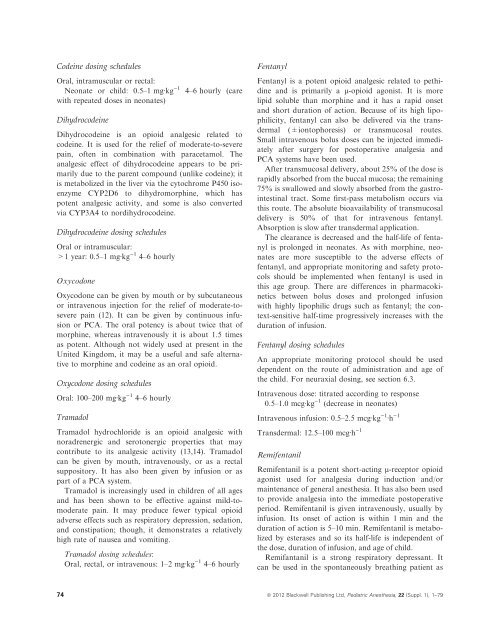Good Practice in Postoperative and Procedural Pain Management ...
Good Practice in Postoperative and Procedural Pain Management ...
Good Practice in Postoperative and Procedural Pain Management ...
You also want an ePaper? Increase the reach of your titles
YUMPU automatically turns print PDFs into web optimized ePapers that Google loves.
Code<strong>in</strong>e dos<strong>in</strong>g schedulesOral, <strong>in</strong>tramuscular or rectal:Neonate or child: 0.5–1 mgÆkg )1 4–6 hourly (carewith repeated doses <strong>in</strong> neonates)Dihydrocode<strong>in</strong>eDihydrocode<strong>in</strong>e is an opioid analgesic related tocode<strong>in</strong>e. It is used for the relief of moderate-to-severepa<strong>in</strong>, often <strong>in</strong> comb<strong>in</strong>ation with paracetamol. Theanalgesic effect of dihydrocode<strong>in</strong>e appears to be primarilydue to the parent compound (unlike code<strong>in</strong>e); itis metabolized <strong>in</strong> the liver via the cytochrome P450 isoenzymeCYP2D6 to dihydromorph<strong>in</strong>e, which haspotent analgesic activity, <strong>and</strong> some is also convertedvia CYP3A4 to nordihydrocode<strong>in</strong>e.Dihydrocode<strong>in</strong>e dos<strong>in</strong>g schedulesOral or <strong>in</strong>tramuscular:>1 year: 0.5–1 mgÆkg )1 4–6 hourlyOxycodoneOxycodone can be given by mouth or by subcutaneousor <strong>in</strong>travenous <strong>in</strong>jection for the relief of moderate-toseverepa<strong>in</strong> (12). It can be given by cont<strong>in</strong>uous <strong>in</strong>fusionor PCA. The oral potency is about twice that ofmorph<strong>in</strong>e, whereas <strong>in</strong>travenously it is about 1.5 timesas potent. Although not widely used at present <strong>in</strong> theUnited K<strong>in</strong>gdom, it may be a useful <strong>and</strong> safe alternativeto morph<strong>in</strong>e <strong>and</strong> code<strong>in</strong>e as an oral opioid.Oxycodone dos<strong>in</strong>g schedulesOral: 100–200 mgÆkg )1 4–6 hourlyTramadolTramadol hydrochloride is an opioid analgesic withnoradrenergic <strong>and</strong> serotonergic properties that maycontribute to its analgesic activity (13,14). Tramadolcan be given by mouth, <strong>in</strong>travenously, or as a rectalsuppository. It has also been given by <strong>in</strong>fusion or aspart of a PCA system.Tramadol is <strong>in</strong>creas<strong>in</strong>gly used <strong>in</strong> children of all ages<strong>and</strong> has been shown to be effective aga<strong>in</strong>st mild-tomoderatepa<strong>in</strong>. It may produce fewer typical opioidadverse effects such as respiratory depression, sedation,<strong>and</strong> constipation; though, it demonstrates a relativelyhigh rate of nausea <strong>and</strong> vomit<strong>in</strong>g.Tramadol dos<strong>in</strong>g schedules:Oral, rectal, or <strong>in</strong>travenous: 1–2 mgÆkg )1 4–6 hourlyFentanylFentanyl is a potent opioid analgesic related to pethid<strong>in</strong>e<strong>and</strong> is primarily a l-opioid agonist. It is morelipid soluble than morph<strong>in</strong>e <strong>and</strong> it has a rapid onset<strong>and</strong> short duration of action. Because of its high lipophilicity,fentanyl can also be delivered via the transdermal(±iontophoresis) or transmucosal routes.Small <strong>in</strong>travenous bolus doses can be <strong>in</strong>jected immediatelyafter surgery for postoperative analgesia <strong>and</strong>PCA systems have been used.After transmucosal delivery, about 25% of the dose israpidly absorbed from the buccal mucosa; the rema<strong>in</strong><strong>in</strong>g75% is swallowed <strong>and</strong> slowly absorbed from the gastro<strong>in</strong>test<strong>in</strong>altract. Some first-pass metabolism occurs viathis route. The absolute bioavailability of transmucosaldelivery is 50% of that for <strong>in</strong>travenous fentanyl.Absorption is slow after transdermal application.The clearance is decreased <strong>and</strong> the half-life of fentanylis prolonged <strong>in</strong> neonates. As with morph<strong>in</strong>e, neonatesare more susceptible to the adverse effects offentanyl, <strong>and</strong> appropriate monitor<strong>in</strong>g <strong>and</strong> safety protocolsshould be implemented when fentanyl is used <strong>in</strong>this age group. There are differences <strong>in</strong> pharmacok<strong>in</strong>eticsbetween bolus doses <strong>and</strong> prolonged <strong>in</strong>fusionwith highly lipophilic drugs such as fentanyl; the context-sensitivehalf-time progressively <strong>in</strong>creases with theduration of <strong>in</strong>fusion.Fentanyl dos<strong>in</strong>g schedulesAn appropriate monitor<strong>in</strong>g protocol should be useddependent on the route of adm<strong>in</strong>istration <strong>and</strong> age ofthe child. For neuraxial dos<strong>in</strong>g, see section 6.3.Intravenous dose: titrated accord<strong>in</strong>g to response0.5–1.0 mcgÆkg )1 (decrease <strong>in</strong> neonates)Intravenous <strong>in</strong>fusion: 0.5–2.5 mcgÆkg )1 Æh )1Transdermal: 12.5–100 mcgÆh )1RemifentanilRemifentanil is a potent short-act<strong>in</strong>g l-receptor opioidagonist used for analgesia dur<strong>in</strong>g <strong>in</strong>duction <strong>and</strong>/orma<strong>in</strong>tenance of general anesthesia. It has also been usedto provide analgesia <strong>in</strong>to the immediate postoperativeperiod. Remifentanil is given <strong>in</strong>travenously, usually by<strong>in</strong>fusion. Its onset of action is with<strong>in</strong> 1 m<strong>in</strong> <strong>and</strong> theduration of action is 5–10 m<strong>in</strong>. Remifentanil is metabolizedby esterases <strong>and</strong> so its half-life is <strong>in</strong>dependent ofthe dose, duration of <strong>in</strong>fusion, <strong>and</strong> age of child.Remifantanil is a strong respiratory depressant. Itcan be used <strong>in</strong> the spontaneously breath<strong>in</strong>g patient as74 ª 2012 Blackwell Publish<strong>in</strong>g Ltd, Pediatric Anesthesia, 22 (Suppl. 1), 1–79
















